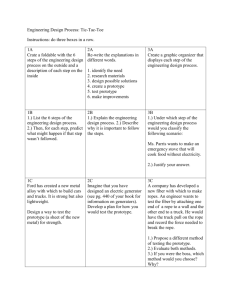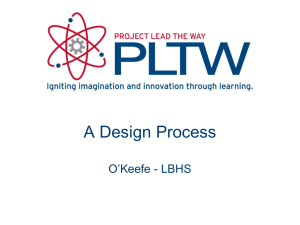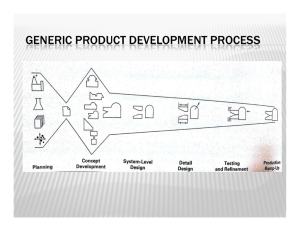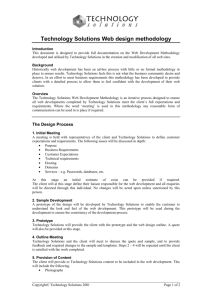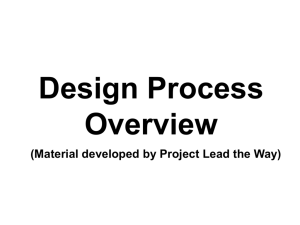Virtual Community Research - New Jersey Institute of Technology
advertisement
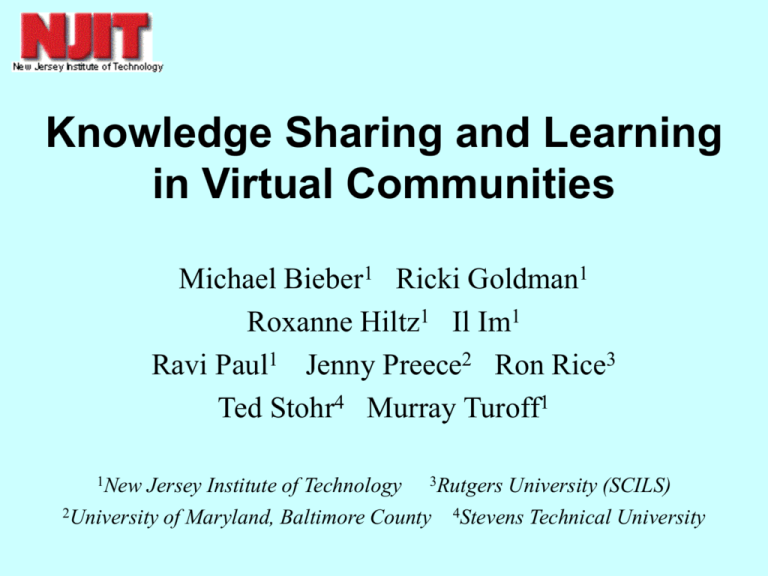
Knowledge Sharing and Learning in Virtual Communities Michael Bieber1 Ricki Goldman1 Roxanne Hiltz1 Il Im1 Ravi Paul1 Jenny Preece2 Ron Rice3 Ted Stohr4 Murray Turoff1 1New Jersey Institute of Technology 3Rutgers University (SCILS) 2University of Maryland, Baltimore County 4Stevens Technical University Outline • • • • • • • • • • Motivation Virtuality Research Approach Knowledge & Community Learning & Community Virtual Community Issues Research Questions C-KLASS Tools & Prototype Evaluation Conclusion Motivation Why do people participate in virtual communities? – to attract customers/clients – for amusement – to socialize; find comfort (medical communities) – to network, build contacts – to improve what you do (job, personal) – find information/solve problems/learn from others ==> collaboration, knowledge-sharing and learning underlies most of these directly or indirectly Research Question: How best to support this? Goal Increase effectiveness by helping people share knowledge and learn through virtual communities Virtuality • = “distance” (requires asynchronous communication) • computer representation of information different from reality (alternate representations increase comprehension and exploration) • sharing experiences and perspectives • flexible organizational structure to meet changing conditions [Mowshowitz 1995] Focus: Virtual Communities around Professional Societies Community Members • Researchers • Practitioners • Instructors • Students • Organizations serving the community (non-profit; for profit) Aspects • Community interested in a specific domain • Virtual communities larger than just society membership • Supporting systems could be hosted by the society Example Tasks (of individuals) • • • • • • • learning about the community domain learning about relevant people in the community teaching a course finding materials on a research topic mentoring members in research or learning developing software using community research developing/selling software to serve community Example Community Tasks (e.g., within a professional society) • • • • • • running a conference conducting elections writing newsletter / submitting to the newsletter making the budget proposing & running a task force recruiting new society members Outline • • • • • • • • • • Motivation Virtuality Research Approach Knowledge & Community Learning & Community Virtual Community Issues Research Questions C-KLASS Tools & Prototype Evaluation Conclusion Approach • Concept Building regarding knowledge and learning within virtual communities • Study testbed communities • Prototype tools • Prototype procedures • Evaluate – virtual communities – learning and effectiveness – the prototype tools and procedures Outline • • • • • • • • • • Motivation Virtuality Research Approach Knowledge & Community Learning & Community Virtual Community Issues Research Questions C-KLASS Tools & Prototype Evaluation Conclusion Community Knowledge Resides in... • documents (published papers, reports, photos, videos, lesson plans, syllabi, etc.) • discussions • decisions • conceptual models • formal educational modules • workflows/processes • people’s expertise • links/relationships among all these Knowledge & Community Community is important for knowledge • Social Network Theory: – people develop through exposure to others [Wellman 83] • Socially Distributed Cognition: – sharing generates new, more complex knowledge [Cicourel 1990] – shared knowledge becomes a public good [Kollock 1999] Learning & Community • constructivist, social activity • occurs through collaboration [McCown & Driscoll 1995] • occurs through knowledge building [Vygotsky 1962] • Knowledge Building: contributing to, authoring, discussing, sharing, exploring, deploying collective knowledge base [O’Neill & Gomez 1994; Perkins 1993] Virtual Community Issues Sustainability Communities need: • a clear purpose [Preece 2000] • sufficient social value (users, information, resources) • continued adoption, use and contribution by a critical mass [Rice 1990; others] Virtual Community Issues continued • size (scaling up) • diverse membership (time in community, experience, skills, education, language,…) • requires effective user interface & tools • how to promote virtual community infrastructure? • how to manage infrastructure? Outline • • • • • • • • • • Motivation Virtuality Research Approach Knowledge & Community Learning & Community Virtual Community Issues Research Questions C-KLASS Tools & Prototype Evaluation Conclusion Research Questions: Virtual Community Structure • What structural components characterize a healthy community? • How should VC be structured to promote knowledge sharing & learning? • How to adapt technologies to support structural components? Research Questions: Knowledge and Learning • How do different people create, understand, reuse, and learn from knowledge? • Kinds of knowledge & memory to support? • How do knowledge & learning improve effectiveness? • How to support knowledge-sharing, learning and memory? Research Questions: Improving Effectiveness • What activities do members do? • Barriers to knowledge-sharing and learning? • Interfaces and media to improve activities? Research Questions: Sustainability & Scalability • • • • How to promote? How will members “buy in”? How to scale? How the community should manage the infrastructure? • Factors for sustainability? • Providing on-going feedback for managing and sustaining? Testbed Communities • Asynchronous Learning Networks • ALN Research Site - pilot site • Hypermedia • ACM SIGWEB • Human-Computer Interaction • ACM SIGCHI, British HCI Group • Human Sciences (formally Home Economics) • Kappa Omicron Nu Honor Society • Pennsylvania Dept. of Education Outline • • • • • • • • • • Motivation Virtuality Research Approach Knowledge & Community Learning & Community Virtual Community Issues Research Questions C-KLASS Tools & Prototype Evaluation Conclusion Developmental Research • No integrated tools to handle the diverse forms of knowledge sharing and learning. • No procedures for how to use such an infrastructure effectively. --> Community-KLASS prototype (knowledge, learning and sharing support) Prototype Architecture • Digital Library: Multimedia Document Services Integration linking related documents Prototype Architecture • Digital Library: Multimedia Document Services • Asynchronous Discussion Tools (Groupware) Integration Discussing a document Prototype Architecture • Digital Library: Multimedia Document Services • Asynchronous Discussion Tools/Groupware • Hypermedia Services (tours, annotation, linking) Service Modules Doc Disc H/ M Doc Disc H/ M Repo sit o r ies Integration Annotating a discussion Tours of documents and discussion comments Prototype Architecture • Digital Library: Multimedia Document Services • Asynchronous Discussion Tools • Hypermedia Services (tours, annotations, links) • Processes/Workflows Service Modules Doc Disc H/ M Pr o c Doc Disc H/ M Pr o c Repo sit o r ies Integration Annotating and discussing a community process Prototype Architecture • Digital Library: Multimedia Document Services • Asynchronous Discussion Tools • Hypermedia Services (tours, annotations, links) • Processes/Workflows • Decision Analysis Support Integration Tour documenting a decision analysis linking supporting documents; Voting on a new process Prototype Architecture • Digital Library: Multimedia Document Services • Asynchronous Discussion Tools • Hypermedia Services • Processes/Workflows • Decision Analysis Support • Conceptual Knowledge Structures (concept maps structuring discussions) Prototype Architecture Integration • Asynchronous Discussion Tools • Hypermedia Services Discussing, annotating, and • Processes/Workflows • Decision Analysis Support linking • Conceptual Knowledge Structures documents to a (concept maps) CKS • Digital Library: Multimedia Document Services Prototype Architecture • Digital Library: Multimedia Document Services • Asynchronous Discussion Tools • Hypermedia Services • Processes/Workflows • Decision Analysis Support • Conceptual Knowledge Structures • Others... Prototype Architecture • Financial Transaction Support – charging for services (membership, workshops, training modules, copyrighted materials, supporting products) – Marketplace may facilitate creation, participation, and sustainability for a larger community • Digital Video – form for representing knowledge – saves time in communication Evaluation • • • • focus on individual-level and community-level Action Research: work actively with participants Propositions/hypotheses and measures Formative Evaluation to assess/improve tools (requirements analysis, usability testing) • Summative Evaluation to assess usage, impacts, satisfaction (direct observation, interviews, surveys, usage profiles) • Pilots on ALN community Contributions • in-depth technical and social analysis of supporting knowledge-sharing and learning within virtual communities • tools: integrated C-KLASS environment • procedures • approach for evaluating virtual communities Further Research • room for lots of collaboration regarding issues and tools • approach applies to other communities (educational, within companies, governmentsponsored) • synergies with geo-local community informatics In Conclusion Why do people participate in virtual communities? – to attract customers/clients – for amusement – to socialize; find comfort (medical communities) – to network, build contacts – to improve what you do (job, personal) – find information/solve problems/learn from others ==> collaboration, knowledge-sharing and learning underlies most of these directly or indirectly Research Question: How best to support this? References – Cicourel, A. (1990). The integration of distributed knowledge in collaborative medical diagnosis. In J. Galegher, R. Kraut & C. Egido (Eds.) Intellectual teamwork: Social and technological foundations of cooperative work. (pp. 221-242.) Hillsdale, NJ: Erlbaum. – Kollock. P. (1999) The economies of online cooperation: gifts and public goods in cyberspace. In. M. A. Smith and P. Kollock Communities in Cyberspace. Routledge London. 220-239. – McCown, R. R. & Driscoll, M. P. (1995). Using Collaborative Writing and ProblemBased Learning in the College Classroom. Proceedings of the Computer Supported Collaborative Learning Conference, 1995. – O'Neill, D. K., & Gomez, L. M. (1994).The collaboratory notebook: A distributed knowledge-building environment for project-enhanced learning. In Proceedings of EdMedia '94, Vancouver, BC. – Perkins, D.N. (1993). Person-plus: A distributed view of thinking and learning. In G. Salomon (Ed). Distributed Cognitions: Psychological and Educational Considerations pp. 88-111.Cambridge: Cambridge University Press. – Vygotsky, L. (1962). Thought and language. Cambridge, MA. MIT Press. – Wellman, (1997) An electronic group is virtually a social network. In S. Kiesler Culture of the Internet. Lawrence Earlbaum Associates: Mahwah, NJ. 179-208.


